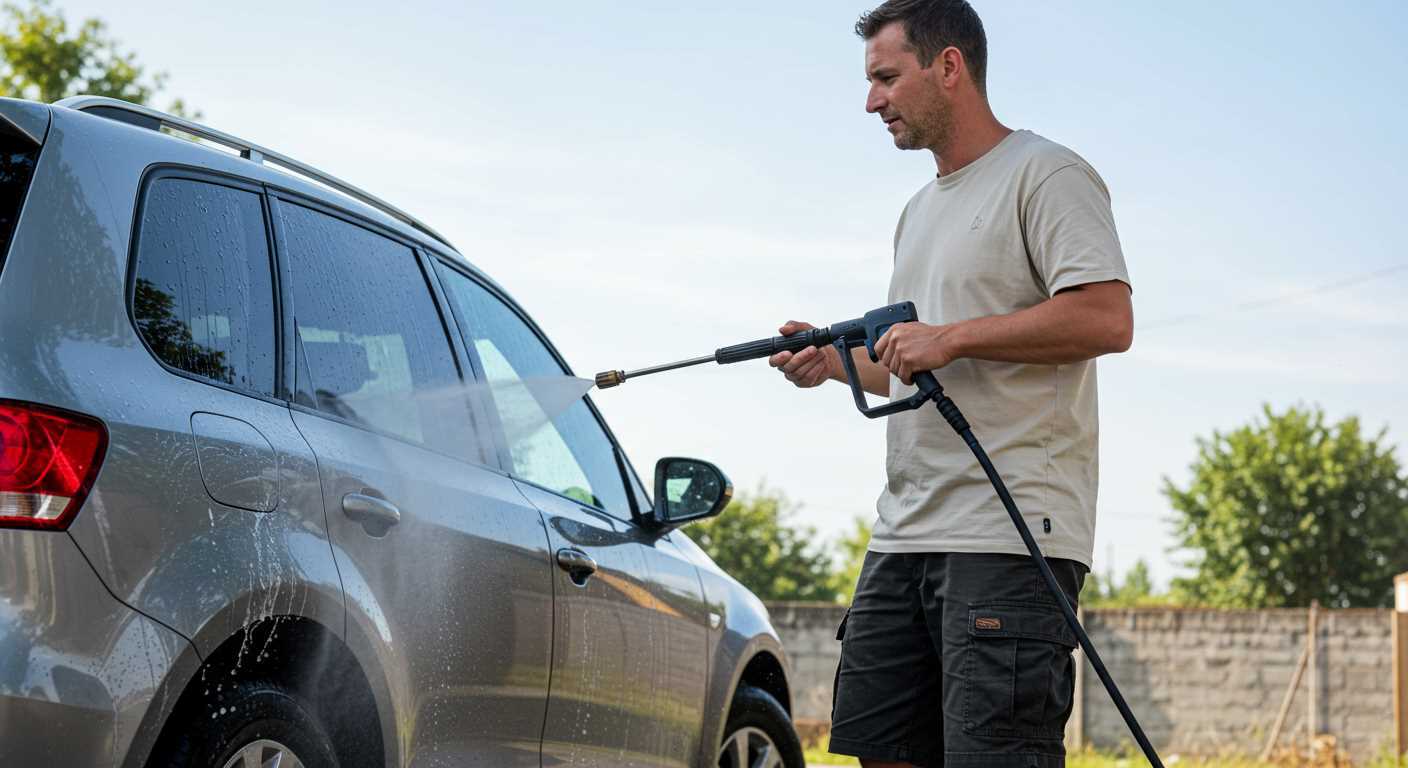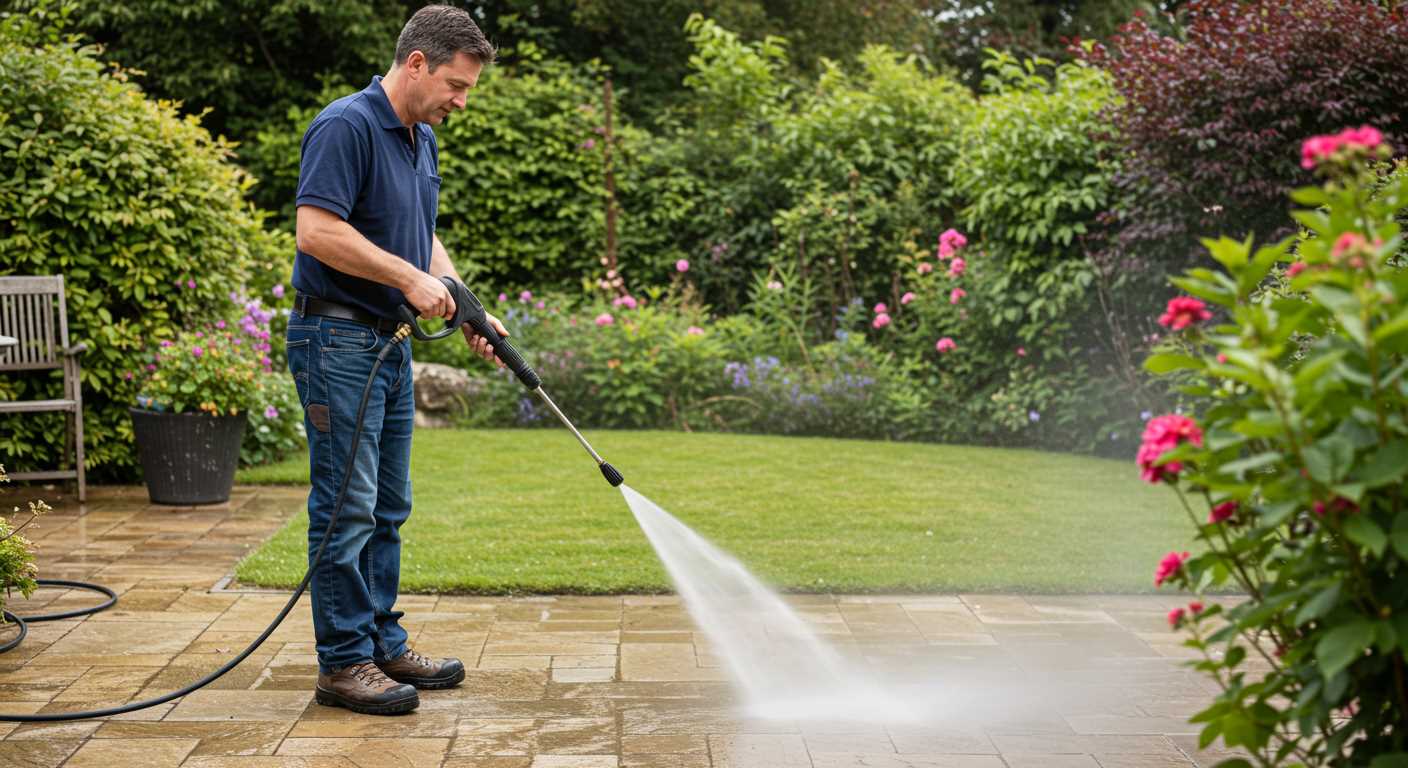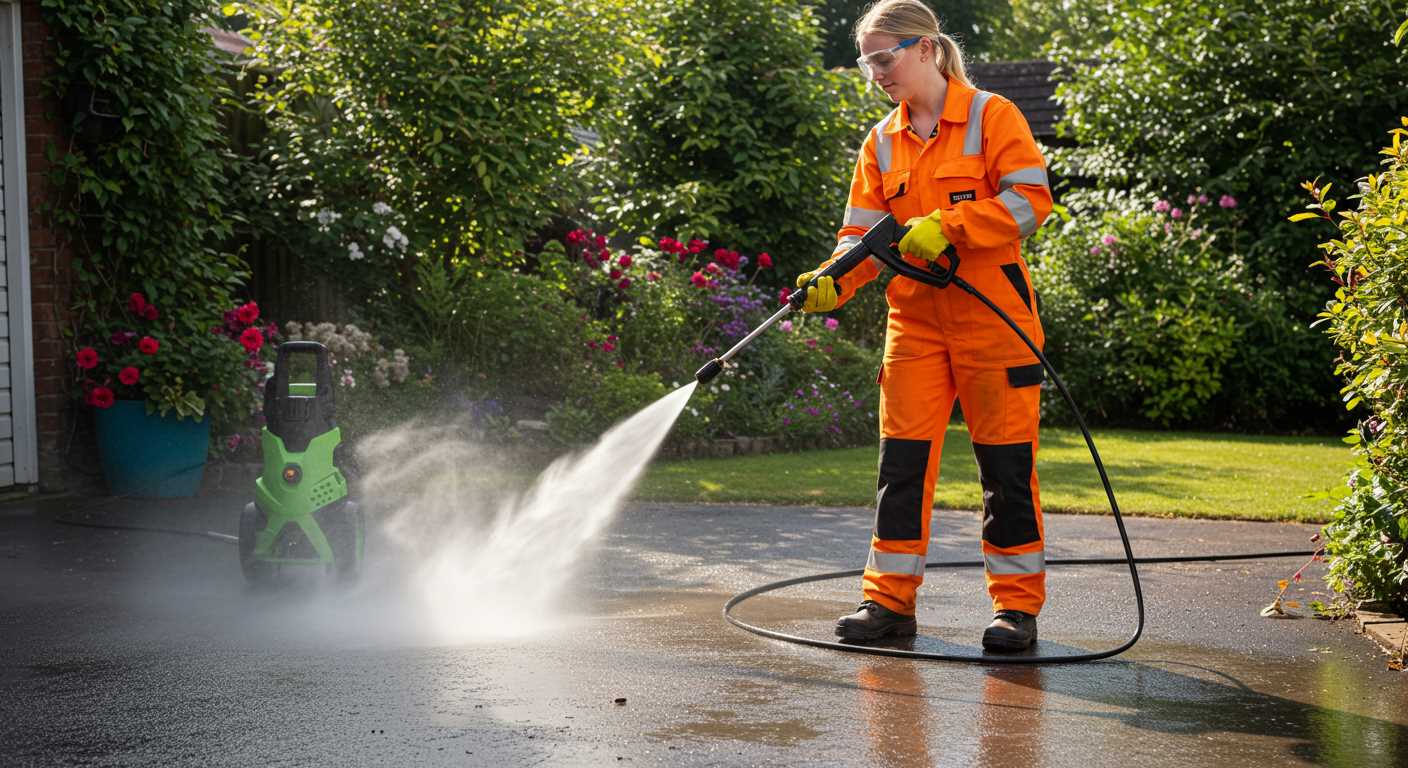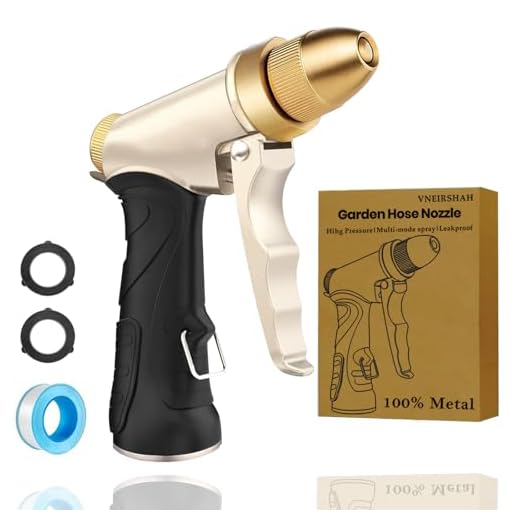



Begin with a mixture of hot water and dish soap. This simple concoction is effective against grease and grime buildup. Pour the solution onto the stained areas, allowing it to sit for at least 15 minutes to break down tough residues.
Next, grab a stiff-bristled broom or scrub brush. This tool is perfect for scrubbing the surface vigorously, ensuring that the dirt gets lifted away. Focus on one small area at a time to ensure thoroughness.
For those stubborn spots, consider a paste made of baking soda and water. Spread it onto the affected areas and let it sit for another 30 minutes. The baking soda will absorb lingering oil and dirt, making it much easier to remove.
After scrubbing, rinse the area with a hose, ensuring that all soap and residue are washed away. A nozzle attachment can provide a more focused stream of water, ideal for rinsing out the corners and crevices.
Regular maintenance can prevent tougher clean-up sessions. A quick sweep every few weeks can mitigate the build-up of dirt and stains, saving time and effort in the long run. Consider using a sealant every couple of years to protect the surface and prolong its lifespan.
Strategies for Maintaining a Neat Surface
Begin with sweeping the area thoroughly. A stiff broom works well to dislodge debris and leaves, making it easier to tackle stains. Consider using a dustpan to collect and dispose of the gathered materials properly.
For stubborn spots, mix a solution of water and baking soda or vinegar. Apply with a scrub brush to the affected area, letting it sit for 15-20 minutes before scrubbing. Rinse with a bucket of warm water and repeat if necessary. The mild abrasiveness of baking soda is effective on grime, while vinegar can tackle oil stains.
Addressing Grease and Oil Marks
Combine cornstarch or dish soap with warm water for greasy remnants. Apply directly and allow it to absorb oil for at least 30 minutes before rinsing off. Scrubbing gently with a brush will enhance the cleaning action. For tougher residues, consider commercial degreasers specifically designed for non-pressurized cleaning tasks.
Preventative Measures
After restoring the surface, seal it with an appropriate sealant to protect against future stains. Regular maintenance, such as immediate attention to spills and periodic cleaning, will preserve the surface’s appearance and integrity. Establish a monthly routine to ensure optimal upkeep.
Assessing the Type of Dirt and Stains on Your Driveway
Identifying the substance causing the blemish is essential. Start by examining the colour and texture. Is it oil, dirt, rust, or perhaps organic matter like leaves and moss? This initial assessment guides the choice of cleaning agents and methods.
Common Types of Driveway Contaminants
- Oil Stains: Typically appear dark and slick. Commonly caused by vehicle leaks.
- Dirt and Mud: Usually a mixture of soil and organic material, often washed in by rain.
- Rust Marks: Often reddish-brown, caused by metal tools or vehicles rusting.
- Organic Growth: Green or black spots indicate moss, algae, or mold developing.
Assessing Severity
Evaluate the intensity of the stains. Light smudges may require gentle scrubbing with a soft brush and a mild solution, while deeper stains need targeted treatment using stronger agents. For persistent issues, regular maintenance prevents build-up, ensuring easier removal in the future.
Consider the surface material of the area as well. Concrete may endure harsher treatments than porous stone or asphalt. Always test any cleaning solution in a small, inconspicuous area before broader application to avoid damage.
Choosing the Right Cleaning Solutions for Driveway Materials
Understanding the material of your surface is key before selecting a cleaning agent. For concrete, a mix of water and vinegar is an excellent choice due to its acidity, which helps remove stains and residue. Using a ratio of one part vinegar to four parts water can effectively tackle grime.
For asphalt, mild soap combined with warm water is often sufficient. An option could be a few drops of dish soap mixed in a bucket of water, which allows gentle removal without damaging the material.
Pavers and Bricks
For pavers or bricks, a solution of biodegradable cleaner is advisable. Products specifically designed for these surfaces can lift oil and dirt without affecting the colour or integrity. Always test a small area first to ensure compatibility.
Natural Stone
Natural stone requires a delicate approach. A mixture of warm water with a pH-neutral cleaner or dish soap works best. Avoid acidic substances as they can etch the surface. Additionally, using a soft-bristle brush to apply the solution can help protect the stone’s finish.
Gathering Necessary Tools for Manual Cleaning
Begin with a sturdy broom or push broom, which will be vital for removing loose debris and dirt. Choose one with bristles that can withstand outdoor use. A hand broom and dustpan can also assist in tackling smaller areas with precision.
Scrubbing Equipment
Invest in a stiff-bristle scrub brush, as it allows for effective scrubbing of stubborn marks. Ensure the handle is long enough for comfortable reach without straining your back. If you encounter oil or grease stains, a wire brush may be necessary, but use it cautiously to avoid damaging the surface.
Cleaning Agents

Gather a bucket for mixing your chosen cleaning solutions. For most materials, a mix of warm water and a few drops of dish soap can work wonders. For tougher stains, consider using baking soda or a quality degreaser. Ensure you have a spray bottle for applying solutions evenly and a garden hose for rinsing after scrubbing.
Don’t forget protective gloves and safety goggles; they safeguard against chemicals and debris. A squeegee may help with removing excess liquid after rinsing, while a towel or cloth can assist in wiping down surfaces for a polished finish.
Applying Homemade Cleaning Solutions to Stubborn Stains
For effective removal of persistent blemishes, blending natural ingredients can yield potent results. Here are a few experimental mixtures I recommend:
- Baking Soda Paste: Combine baking soda with water to form a thick paste. Apply directly to the stain, allow it to sit for 15-30 minutes, then scrub with a stiff brush. Rinse thoroughly.
- Vinegar Solution: Mix equal parts white vinegar and water in a spray bottle. Spray generously onto the affected area, wait for 10-15 minutes, and scrub using a mop or brush before rinsing off.
- Lemon Juice and Salt: Squeeze lemon juice over the stain and sprinkle salt on top. Let it marinate for several hours, then scrub and rinse. This combination is effective for rust and organic matter.
- Dish Soap and Warm Water: Combine a few drops of dish soap with hot water in a bucket. Use a scrub brush or mop to work the solution into the stains for a thorough cleanse, then rinse.
Adjust the ratios of ingredients to fit the severity of the stain. Always test these mixtures on an inconspicuous area to ensure no damage occurs to the surface.
For grease marks, I found that a simple mixture of cornstarch and baking soda can absorb excess oil. Sprinkle it over the grease, let it sit for 30 minutes, then sweep it away and follow up with one of the solutions above.
Applying these homemade remedies consistently can lead to noticeable improvements, enhancing the appearance and longevity of the surface.
Using a Broom and Scrub Brush for Basic Maintenance
For quicker tasks, I rely on a sturdy broom and a reliable scrub brush. I suggest starting by sweeping the area to remove loose dirt, leaves, and debris. This initial step maximises the effectiveness of subsequent scrubbing.
Technique for Sweeping

Choose a broom with stiff bristles for concrete surfaces and a softer bristle option for more delicate stone materials. I typically use long, sweeping motions from one side to another, ensuring I reach corners and edges where grime accumulates. Then, collect debris and dispose of it properly.
Scrubbing Method
After preparing the surface, I apply a homemade solution or an all-purpose cleaner suitable for the material. Using a scrub brush with a handle aids in applying pressure while maintaining comfort. For persistent stains, I recommend circular motions, focusing on high-traffic areas or spots that have developed slippery patches.
| Tool | Recommended Use |
|---|---|
| Stiff Bristle Broom | Effective for sweeping debris from concrete hoses |
| Soft Bristle Broom | Safer for delicate stone materials |
| Scrub Brush | Ideal for tackling stubborn stains |
After scrubbing, rinsing the surface with clean water improves the finish. A rubber squeegee or a mop can help remove excess water, preventing new dirt from settling. This manual effort is straightforward yet rewarding, maintaining a presentable exterior efficiently.
Utilising a Garden Hose for Rinsing Off Residue
For effective residue removal, a regular garden hose can work wonders. Start by ensuring the nozzle has an adjustable setting for a concentrated stream. This helps to direct water accurately onto the debris or stains that require attention.
Technique for Effective Rinsing
Begin at one end and gradually move the water flow across the surface. Use the concentrated setting to dislodge dirt particles, allowing them to wash away. It’s crucial to keep a steady motion to prevent pooling and ensure even rinsing throughout the area. For tougher spots, angle the nozzle closer to the surface, but take care not to damage any materials.
Enhancing Results with Hot Water
If your garden hose setup allows for hot water, this can significantly enhance cleaning power. Warm water helps dissolve grease and stubborn stains more effectively. While rinsing, be mindful of temperature limitations for various surfaces to avoid any potential damage.
Maintaining a Clean Driveway with Regular Upkeep
Implement a routine schedule for keeping surfaces pristine. A weekly sweep can remove loose debris such as leaves and dirt, preventing build-up that leads to stains. Set aside a specific time each week or bi-weekly, depending on environmental factors. For high-traffic areas, consider increasing the frequency.
Routine Inspections
Conduct monthly checks to identify early signs of discolouration or damage. Addressing stains immediately makes removal easier and prevents permanent marks. Be vigilant after heavy rain or snow, as these can expose issues previously unnoticed.
Seasonal Maintenance Tips

In spring, clear out any accumulated grime or residue from winter. Use a natural solution, such as vinegar and baking soda, to eliminate organic matter. In autumn, stay proactive by sweeping fallen leaves regularly, which can foster moss growth if left unattended. Each season presents unique challenges; adjust your maintenance tasks accordingly.









